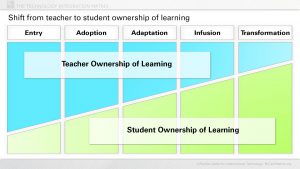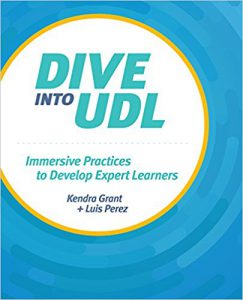The levels of the Technology Integration Matrix describe a range of different pedagogical approaches applied to the use of technology in K-12 classrooms. But how does the TIM relate to assistive technologies that are designed to be used by students with disabilities? Actually, the TIM is very consistent with the goals of assistive technology and can help guide planning and implementation.
TIM levels range from very teacher-centered at the lower levels to very student-centered at the higher levels. In an ENTRY level TIM lesson, the teacher decides which technology to use, when to use it, and how it should be used. As we move toward the right, we see greater student ownership of the process. At the TRANSFORMATION level, a student has meaningful access to a variety of technology tools. The student knows how to use the tools to support his or her own learning and makes strategic choices. The student solves problems using technology, often in innovative ways.

The shift we see across the TIM levels, from a teacher-centered lesson to a student-centered lesson, parallels the shift we hope to see in a student’s use of assistive technologies. Early in a student’s career, teachers, paraprofessionals, and other specialists identify appropriate assistive technologies and direct the student in their use. Ideally, the student will gradually learn to make those choices with increasing independence. Eventually, the goal is for a student to understand his or her own learning needs and use that understanding to choose the technology tools that best support his or her needs. To whatever extent possible, students with disabilities should become informed decision-makers regarding the technology that supports their learning. As described in the TIM, it often makes sense to begin with lessons in which the teacher is the primary decision-maker but student-centered lessons are also necessary and important.
During last month’s TIM Research Roundtable, we were fortunate to be joined by Dr. Luis Pérez, FCIT alum, all-around great guy, and author of Learning on the Go and Dive into UDL, for a great discussion of the role of assistive technology, Universal Design for Learning, and the TIM. Please contact us for free access to the TIM Tools Resource Center to watch our conversation!
Resources:
Luis F. Pérez staff page at CAST
Dive into UDL (Universal Design for Learning): Immersive Practices to Develop Expert Learners Hardcover by Kendra Grant and Luis F. Pérez. Available April 7, 2018

